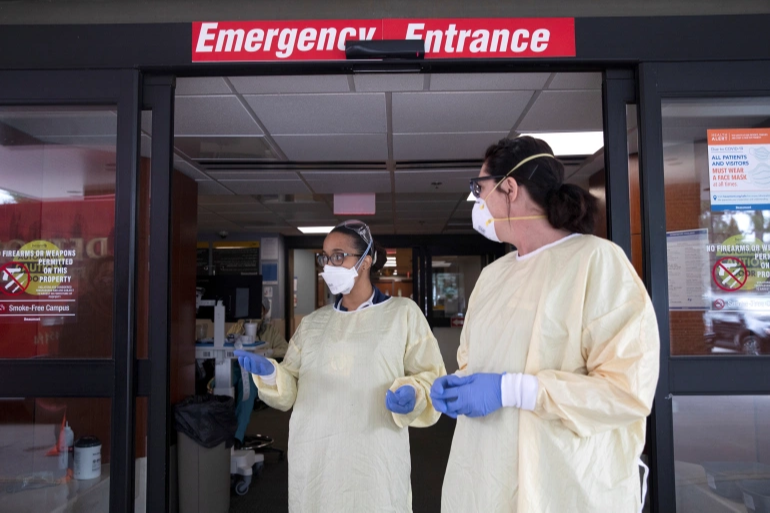
Emergency room nurses talk outside Beaumont Hospital in Grosse Pointe, Michigan. [Photo: Emily Elconin/Reuters]
New York, April 19 (RHC)-- The pediatrician told Melissa Zajacz of Medina, Ohio, that her 13-year-old son, Spencer, would be back to school in two weeks after he was diagnosed with COVID-19. Then came more trips to the doctor, fevers over 104 degrees and two visits to the Cleveland Clinic emergency room.
Spencer’s case, involving the B.1.1.7. variant, has kept him mostly bedridden and suffering headaches and swollen ankles since March 17. “There is no cure, so they offer support care,” said Melissa Zajacz. “He hasn’t been to school in a month. He’s a healthy, athletic kid, and he’s miserable.”
Throughout previous waves of COVID, children and young adults eluded the pandemic’s gravest consequences, exhibiting mild symptoms or none at all. Now faster-spreading variants are sending more to the hospital. Fatalities remain low, but doctors say the virus is now making the young sicker, some gravely.
Cautionary tales are beginning to multiply. University of Alabama students are mourning the death of the basketball team’s unofficial mascot, Luke Ratliff, a 23-year-old plaid-clad campus fixture. The student affectionately known as Fluffopotamus died from COVID-19 complications early this month as the team went on an NCAA tournament run.
In Michigan, where COVID-19 is spreading at one of the planet’s fastest rates — an average of almost 8,000 new cases a day — hospitals are seeing far more youths. The state’s Department of Health and Human Services reported 50 pediatric cases in hospitals last week, the most since the post-holiday surge in early January.
“Statewide, the hospitalization rates are higher, therefore they must be sicker,” said Rudolph Valentini, chief medical officer for Children’s Hospital of Michigan in Detroit. “We’re seeing more kids coming to ER across the state. Some are in ICU, and some require mechanical ventilation.”
The new COVID-19 variants are more contagious and hit young people harder than the original virus that emerged more than a year ago, when people under 30 often showed no symptoms. “We are seeing patients 20, 25, 35 who are quite ill with COVID,” Robert Riney, chief operating officer for Henry Ford Health System, said in an April 8 briefing. “The good news is the mortality rates are lower, but these are not light cases.”
The same trend is showing up across the U.S. as young people, who often aren’t yet vaccinated, spread and contract the virus through school sports and social gatherings. Most states have focused vaccination efforts on residents over 65 because they’re most vulnerable.

